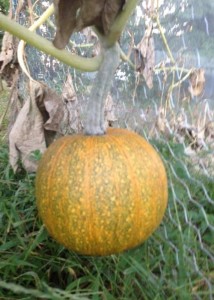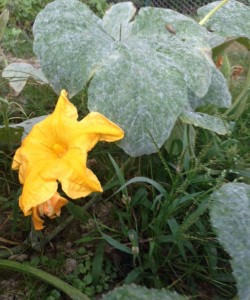Pumpkins are one of fall’s staples, right alongside apples and the changing color of leaves.
If you planted pumpkins this year and were disappointed in how they turned out, or if you’re planning on planting pumpkins next summer, keep these 7 tips in mind:
1. Apply fertilizer
According to Purdue University Cooperative Service Extension, pumpkins need low nitrogen, high potassium and high phosphorus for successful growing.
Before planting seeds, apply a tablespoon or two per hill of 4-8-5 or 6-10-10 fertilizer.
2. Prune vines

The Old Farmer’s Almanac suggests pinching off the ends of vines after several pumpkins have formed on each one. This will help the plant focus energy on those pumpkins instead of using energy to continue growing the vine.
If your pumpkin vines are growing wild, you can prune them. Just like pinching the ends of vines, pruning will help to direct energy on the existing pumpkins.
3. Use insecticides wisely
Pumpkins are typically affected by squash bugs, aphids, squash vine borer and cucumber beetles.Insecticides should be used wisely so pollination isn’t affected or prevented altogether.
Bees are necessary to pollinate both male and female pumpkin blooms. University of Illinois Extension states that if you want to use insecticides, wait until blooms are closed during late afternoon or early evening so that bees don’t come in contact with the insecticides.
4. Use mulch to control weeds
Mulch helps to suppress weeds. Purdue University Cooperative Service Extension recommends using black plastic mulch, which can be installed either a couple weeks before planting or even just a few days before. Organic mulch can work, too.
If you choose not to apply mulch, you may have to use a hoe to carefully remove weeds from your pumpkin patch.
5. Choose the proper location
Pumpkins need to be planted in full sun. The soil needs neutral or slightly alkaline and should also be easily drained.
Purdue University Cooperative Service Extension recommends planting pumpkins in soil with a pH of 7.0. If you’re not sure of your soil’s pH level or fertility, have your soil tested.
6. Properly space seeds
Pumpkins need a lot of space to grow. Seeds should be planted on small hills, but vines will quickly sprawl dozens of feet, even climbing fences like a trellis if the fences are in the path of the growing vines.
To ensure that your other plants aren’t choked out by your pumpkins, give pumpkins 50 to 100 square feet per hill, according to University of Illinois Extension. Leave 5 to 6 feet between hills and rows 10 to 15 feet apart. Once pumpkins are well-established, thin them to the best two or three plants.
The following planting instructions for semi-bush, bush and miniature pumpkins are adapted from the University of Illinois Extension:
- If you’re planting semi-bush pumpkins, leave 4 feet between hills and 8 feet between rows. 4 or 5 seeds should be planted per hill and then thinned to the best two plants after they begin to grow.
- For bush pumpkins, plant one or two seeds per foot of each row, then thin to one plant every yard. Rows should be 4 to 6 feet apart.
- Plant 2 or 3 miniature pumpkin seeds every 2 feet per row. Keep the best seedling for every 2 feet of the row. Rows should be 6 to 8 feet apart.
All pumpkin seed varieties should be planted about one inch deep.
7. Manage mildew

Pumpkins are susceptible to both powdery mildew and downy mildew.
Powdery mildew is small, white powdery spots on plant leaves. Penn State University Extension explains how to manage powdery mildew so that its effects are minimized. Downy mildew appears as angular lesions that can turn brown. Purdue University Extension offers pointers for control measures and fungicides.
3 more posts about pumpkins:
- How to pick the perfect pumpkin, gourd or squash
- Pumpkin season: Picking, cooking and preserving fall’s favorite fruit
- Pumpkin decorating ideas for Halloween
STAY INFORMED. SIGN UP!
Up-to-date agriculture news in your inbox!












It has always been a dream of mine to have a Harry Potter-like garden, wherein the pumpkins will be all over my backyard. I’m glad you shared that nitrogen, high potassium, and high phosphorus are the perfect fertilizers to apply to grow pumpkins successfully. I just have to find a seasonal p[umpkin patch around here in Larchmont New York City.
I’ve always heard you can plant pumpkin, corn, and beans together, each supporting the other. I think I may try that this year in Ohio.
You should grow pumpkins around June 15 to July 15 if you live in warmer parts of the state, like the Tidewater and Piedmont regions. Meanwhile, for cooler areas like northern Virginia, June 15 to July 5 will do.